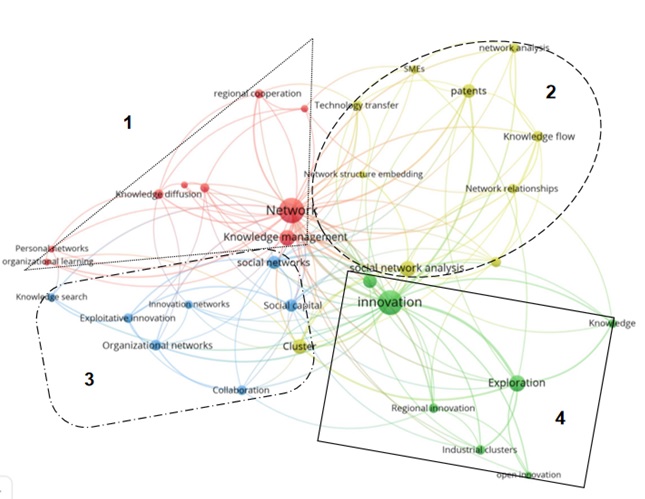 PDF(1966 KB)
PDF(1966 KB)


Research Structure and Development Trend of International Knowledge Network
Yuan Meng
Knowledge Management Forum ›› 2022, Vol. 7 ›› Issue (2) : 178-188.
 PDF(1966 KB)
PDF(1966 KB)
 PDF(1966 KB)
PDF(1966 KB)
Research Structure and Development Trend of International Knowledge Network
[Purpose/Significance] Under the background of organizational networking and knowledge becoming the core element of the organization, it aims to visually recognize the present situation and development of knowledge network research at home and abroad, and provide an important basis for knowledge network research and network innovation and development. [Method/Process] Based on the idea and method of scientific knowledge map, VOSviewer and CiteSpace were comprehensively used, and the "knowledge network" documents of management discipline collected in the core database of Web of Science from 2001 to 2020 were taken as samples to draw the knowledge map and analyze the literature contents, summarized the research status of international knowledge network, revealed its research hotspots, built its content integration framework, and explored its frontier trends. [Result/Conclusion] Finally, four fields of knowledge network research of personal field, enterprise field, regional field and professional field, and four hot research topics of network evolution research, network architecture research, network characteristics research and network innovation research, were identified. Based on this, four frontier directions of dynamic knowledge network direction, complex knowledge network direction, multiple-level knowledge network direction and innovative knowledge network direction, were put forward.

knowledge network / knowledge map / cluster analysis / research focus
| [ |
SU J F,BAI Q, SINDAKIS S, et al. Vulnerability of multinational corporation knowledge network facing resource loss: a super-network perspective[J]. Management decision, 2021,59(1): 84-103.
|
| [ |
GIUDICE M D, MAGGIONI V. Managerial practices and operative directions of knowledge management within inter-firm networks: a global view[J]. Journal of knowledge management, 2014, 18(5): 841-846.
|
| [ |
李丹,俞竹超,樊治平. 知识网络的构建过程分析[J]. 科学学研究, 2002(6): 620-623.
|
| [ |
OWEN-SMITH J, POWELL W W. Knowledge networks as channels and conduits: the effects of spillovers in the Boston biotechnology community[J]. Organization science, 2004, 15(1): 5-21.
|
| [ |
李勇,史占中,屠梅曾. 知识网络与企业动态能力[J]. 情报科学, 2006(3): 434-437.
|
| [ |
HANSEN M T. Knowledge networks: explaining effective knowledge sharing in multiunit companies[J]. Organization science, 2002, 13(3): 232-248.
|
| [ |
KONG E. The future of knowledge: increasing prosperity through value networks : Verna Allee[J]. Knowledge and process management, 2003, 10(2): 137-138.
|
| [ |
魏江,徐蕾. 知识网络双重嵌入、知识整合与集群企业创新能力[J]. 管理科学学报, 2014, 17(2): 34-47.
|
| [ |
WANG J. A knowledge network constructed by integrating classification, thesaurus, and metadata in digital library[J]. International information and library review, 2003, 35(2-4): 383-397.
|
| [ |
李柏洲,徐广玉,苏屹. 团队知识转移风险对知识转移绩效的作用路径研究——知识网络的中介作用和团队共享心智模式的调节作用[J]. 科研管理, 2014, 35(2): 127-135.
|
| [ |
BRENNECKE J, RANK O. The firm's knowledge network and the transfer of advice among corporate inventors—a multilevel network study[J]. Research policy, 2017, 46(4): 768-783.
|
| [ |
肖冬平,顾新. 基于自组织理论的知识网络结构演化研究[J]. 科技进步与对策, 2009, 26(19): 168-172.
|
| [ |
肖冬平,顾新,彭雪红. 基于嵌入视角下知识网络中的知识流动研究[J]. 情报杂志, 2009, 28(8): 116-125.
|
| [ |
XU L Y, LI J, ZHOU X. Exploring new knowledge through research collaboration: the moderation of the global and local cohesion of knowledge networks[J]. The journal of technology transfer, 2019, 44(3): 822-849.
|
| [ |
CHOUDHURY N, FAISAL F, KHUSHI M. Mining temporal evolution of knowledge graphs and genealogical features for literature-based discovery prediction[J]. Journal of informetrics, 2020, 14(3): 57-80.
|
| [ |
ARGYRO N, LIOUKAS S, VOUDOURIS I. Network structure and firm-level entrepreneurial behavior: the role of market and technological knowledge networks[J]. Journal of business research, 2020, 106(8): 129-138.
|
| [ |
BALLAND P A, BOSCHMA R, FRENKEN K. Proximity and innovation: from statics to dynamics[J]. Regional studies, 2014, 49(6): 907-920.
|
| [ |
JUHÁSZ S. Spinoffs and tie formation in cluster knowledge networks[J]. Small business economics, 2019, 56(9): 1-20.
|
| [ |
汤超颖,黄冬玲. 知识网络与创造力的国内外研究综述[J]. 科学学与科学技术管理, 2016, 37(3): 43-49.
|
| [ |
PU M, SOH P H. The role of dual embeddedness and organizational learning in subsidiary development[J]. Asia Pacific journal of management, 2018, 35(2): 373-397.
|
| [ |
BERRY H. The influence of multiple knowledge networks on innovation in foreign operations[J]. Organization science, 2018, 29(5): 855-872.
|
| [ |
JUHÁSZ S, LENGYEL B. Creation and persistence of ties in cluster knowledge networks[J]. Journal of economic geography, 2018, 18(6): 1203-1226.
|
| [ |
LEE C Y, WANG M C, HUANG Y C. The double-edged sword of technological diversity in R&D alliances: Network position and learning speed as moderators[J]. European management journal, 2015, 33(6): 450-461.
|
| [ |
NAJAFI-TAVANI S, NAJAFI-TAVANI Z, NAUDÉ P, et al. How collaborative innovation networks affect new product performance: product innovation capability, process innovation capability, and absorptive capacity[J]. Industrial marketing management, 2018, 73(13): 193-205.
|
| [ |
DOOLEY L, GUBBINS C. Inter-organisational knowledge networks: synthesising dialectic tensions of university-industry knowledge discovery[J]. Journal of knowledge management, 2019, 23(10): 2113-2134.
|
| [ |
GUERCINI S, MEDLIN C J. A radical constructivist approach to boundaries in business network research[J]. Industrial marketing management, 2020, 91(4): 510-520.
|
| [ |
VISSAK T, FRANCIONI B, FREEMAN S. Foreign market entries, exits and re-entries: the role of knowledge, network relationships and decision-making logic[J]. International business review, 2020, 29(1): 101-123.
|
| [ |
岳振明,赵树宽. 国外创新网络研究回顾与展望[J]. 科技管理研究, 2020, 40(21): 31-45.
|
/
| 〈 |
|
〉 |